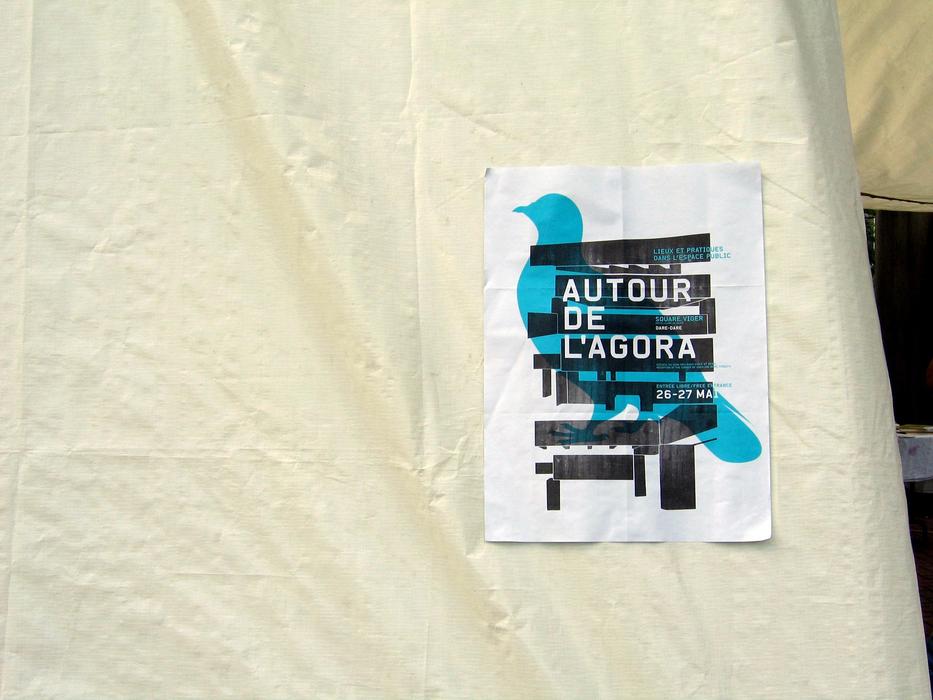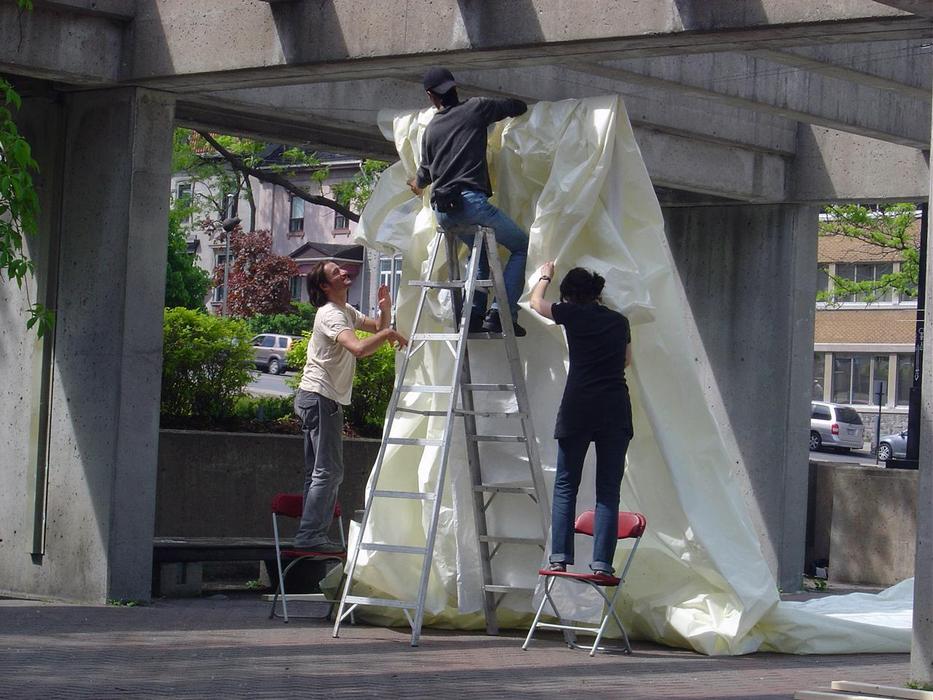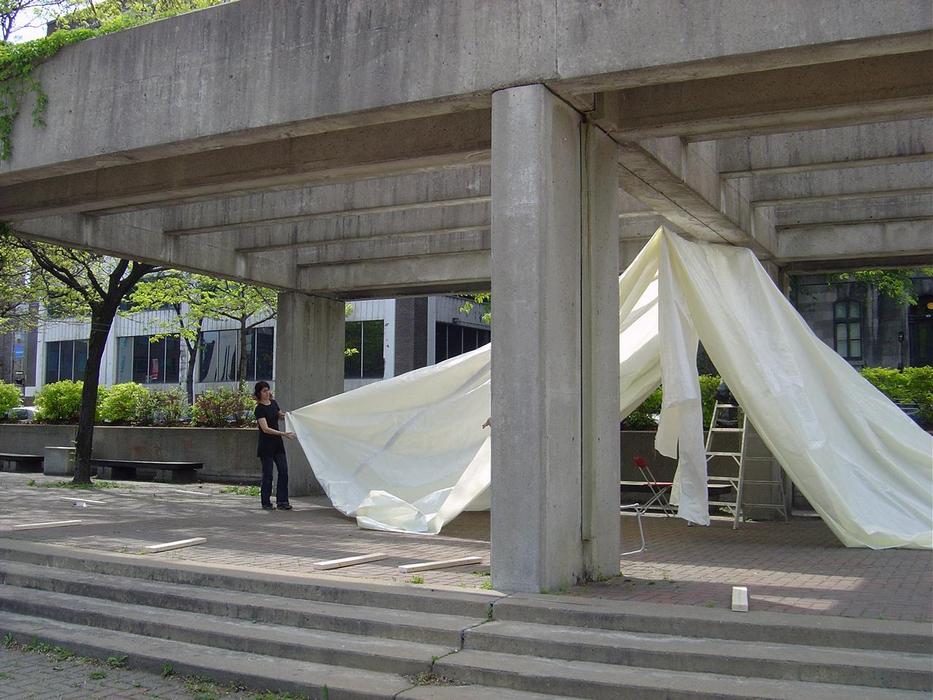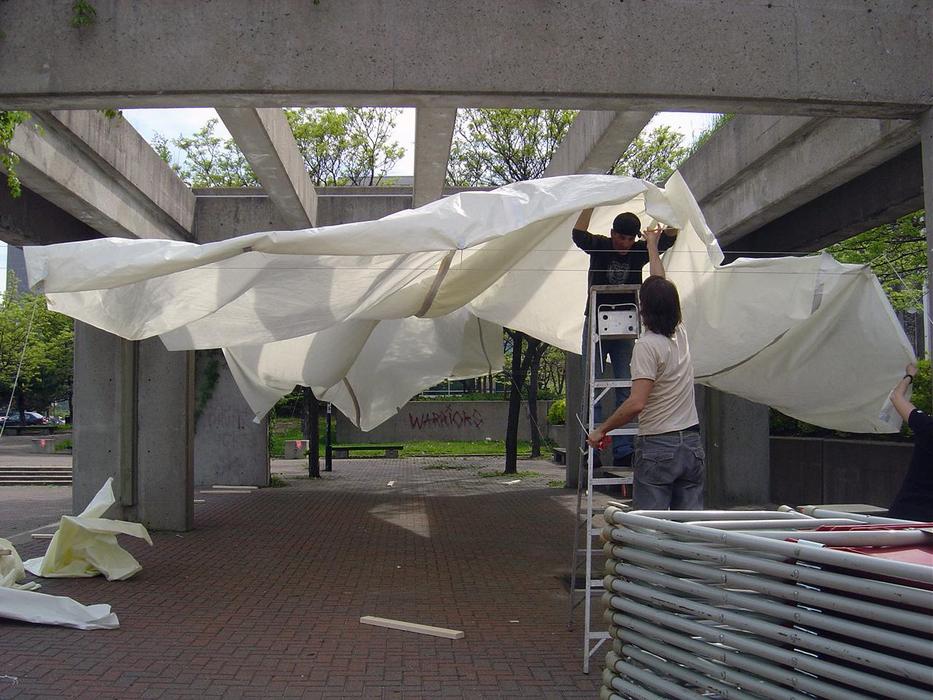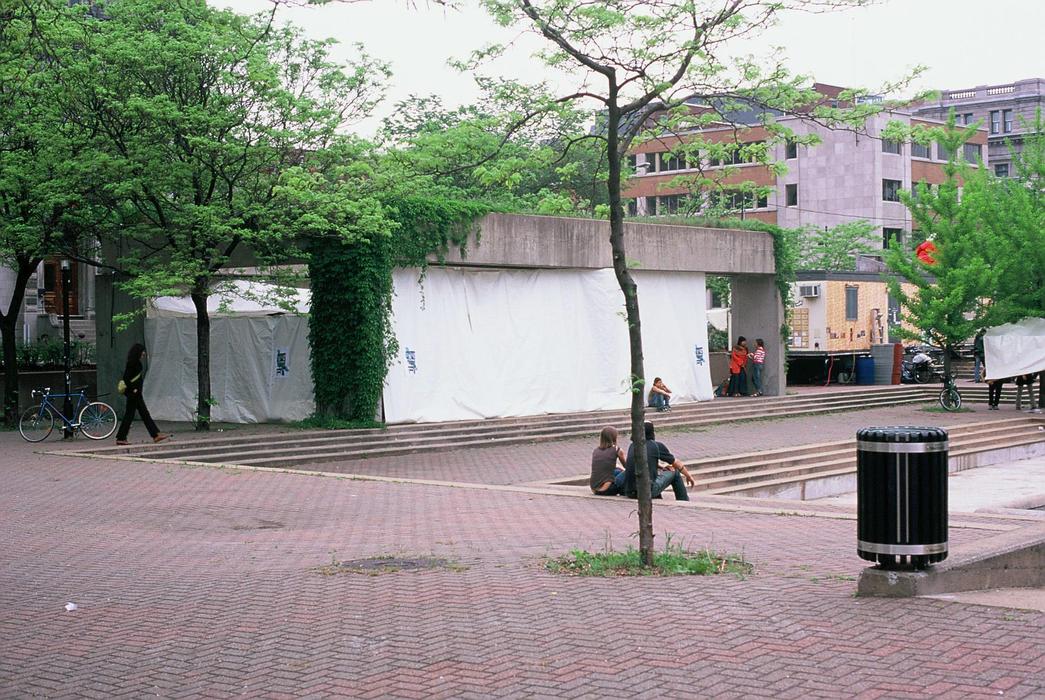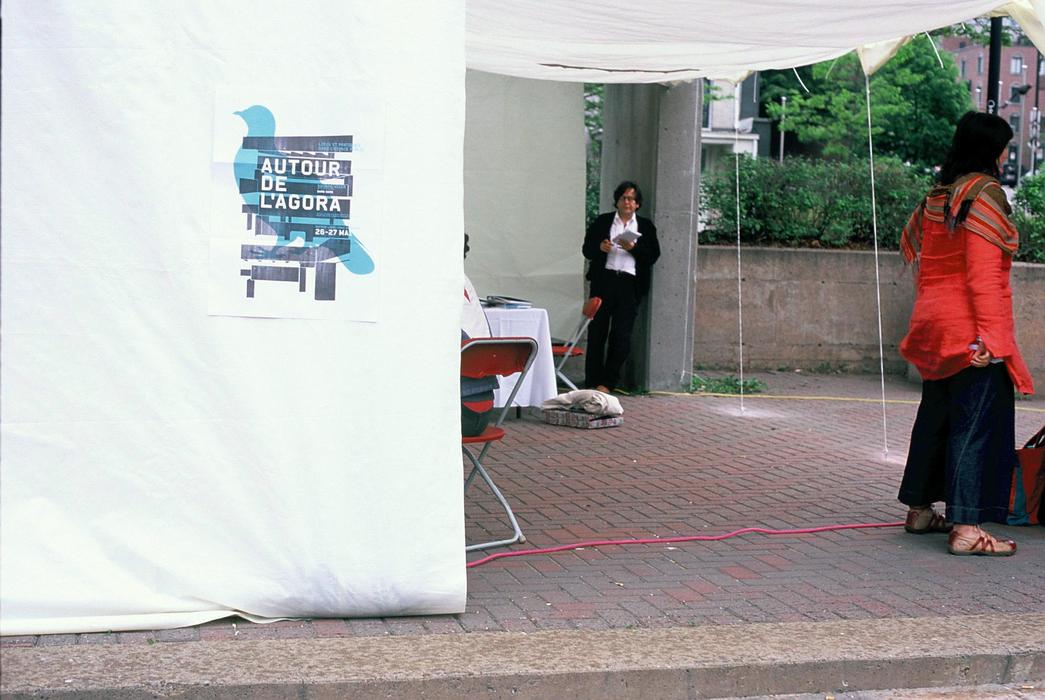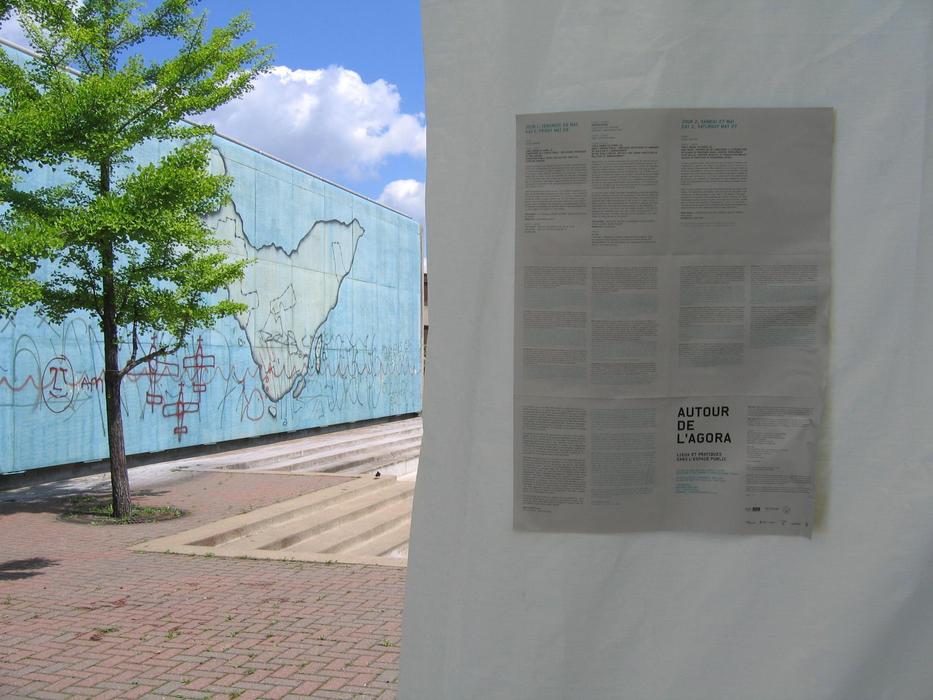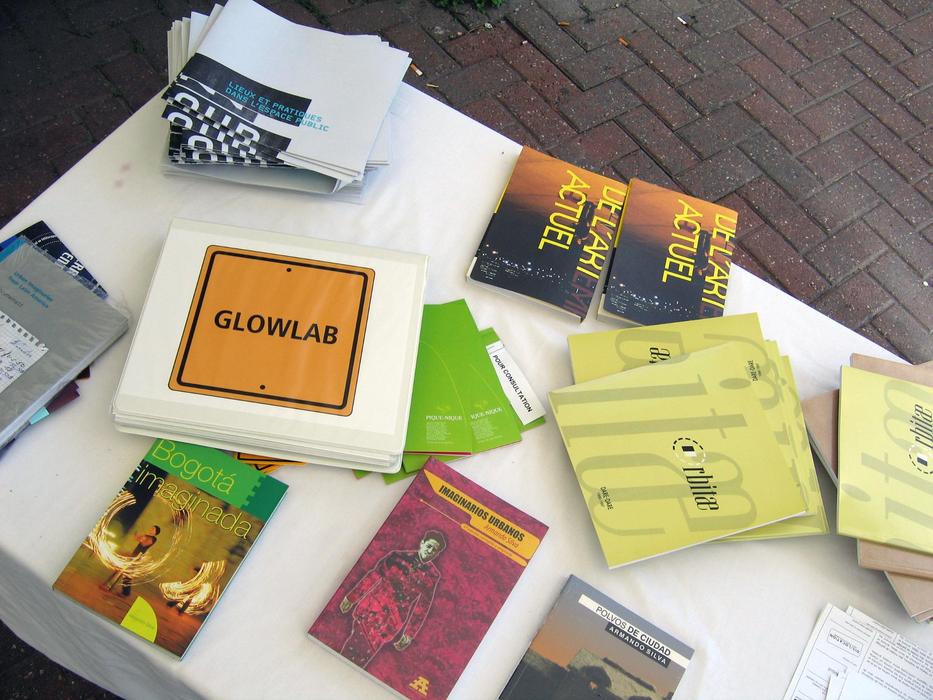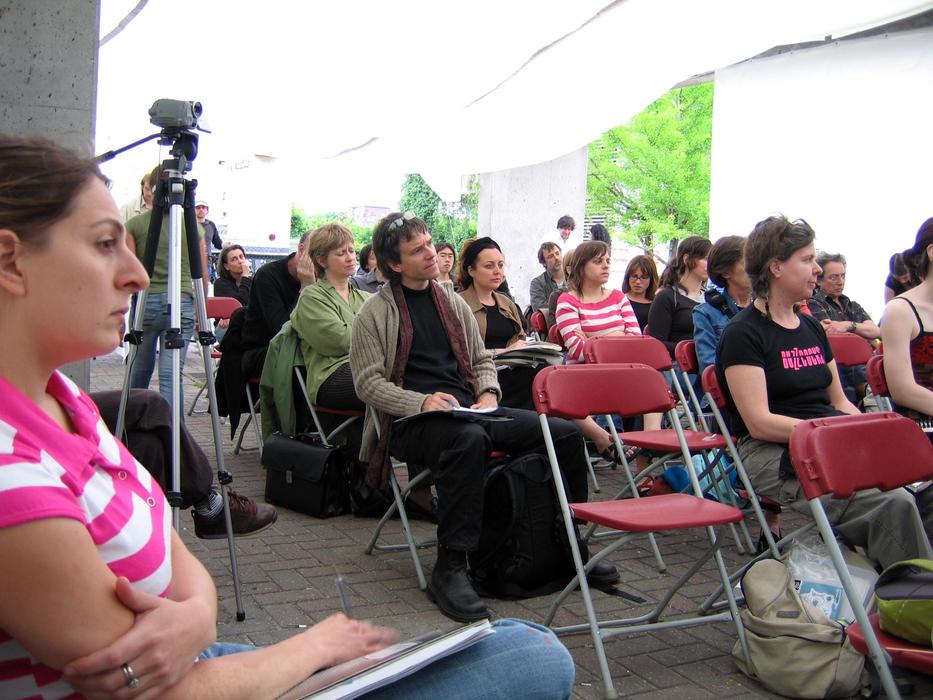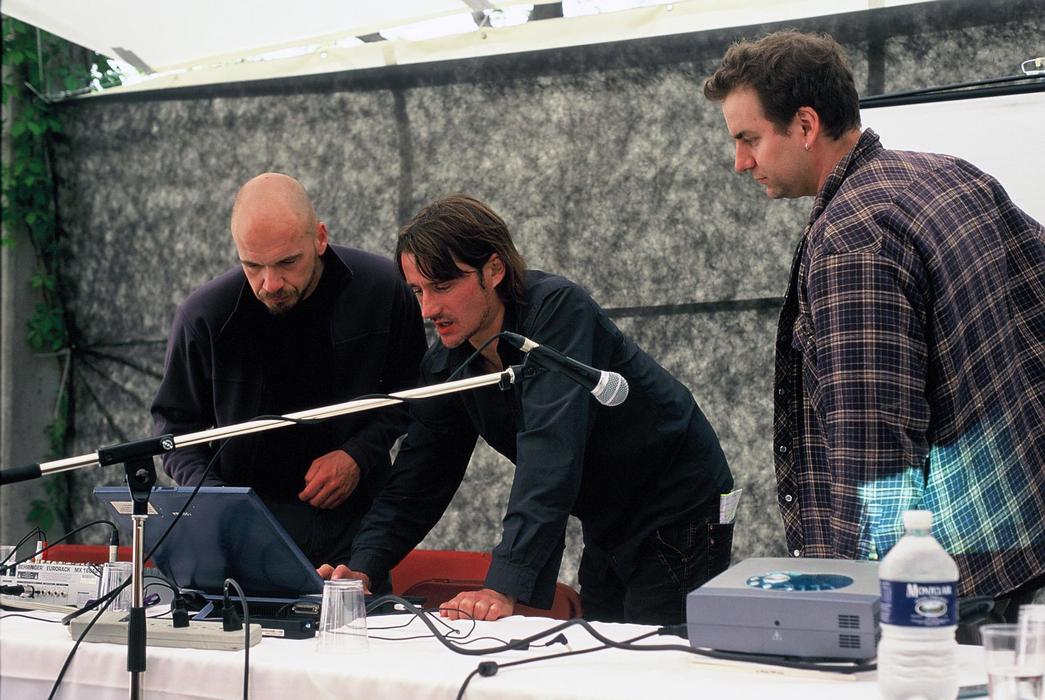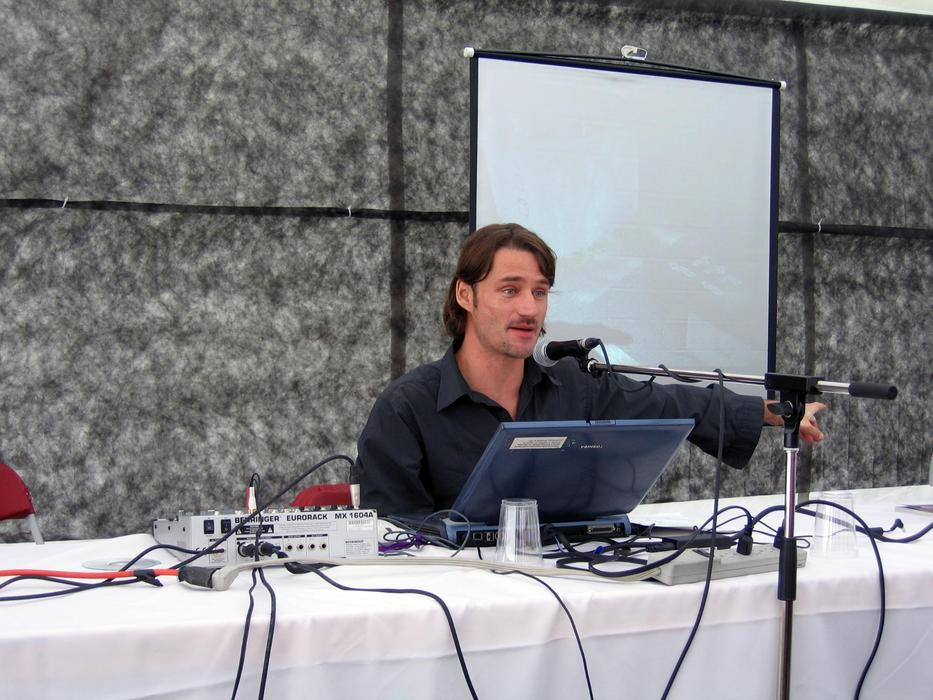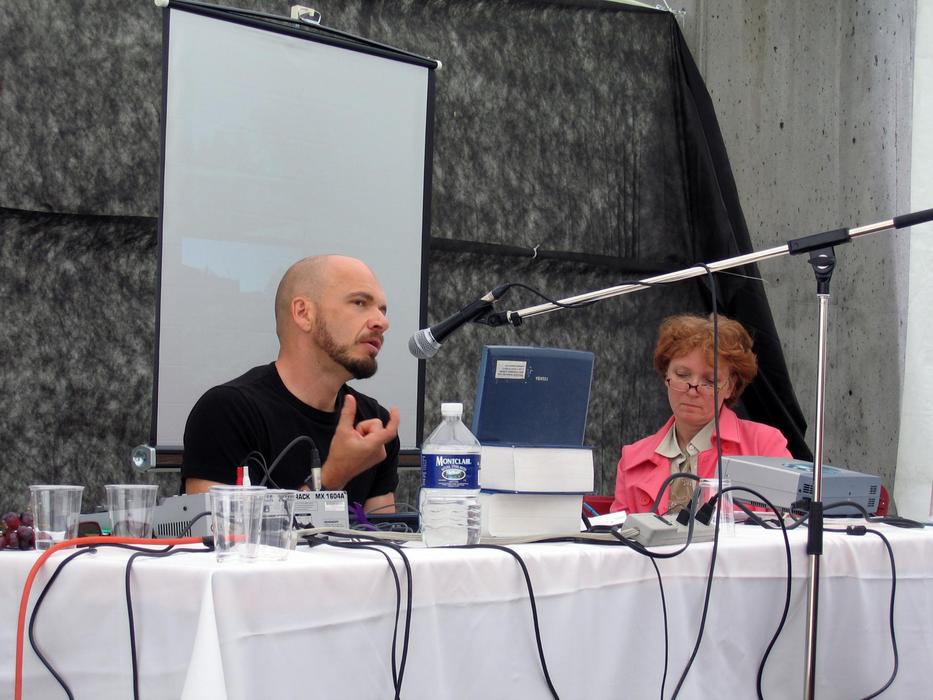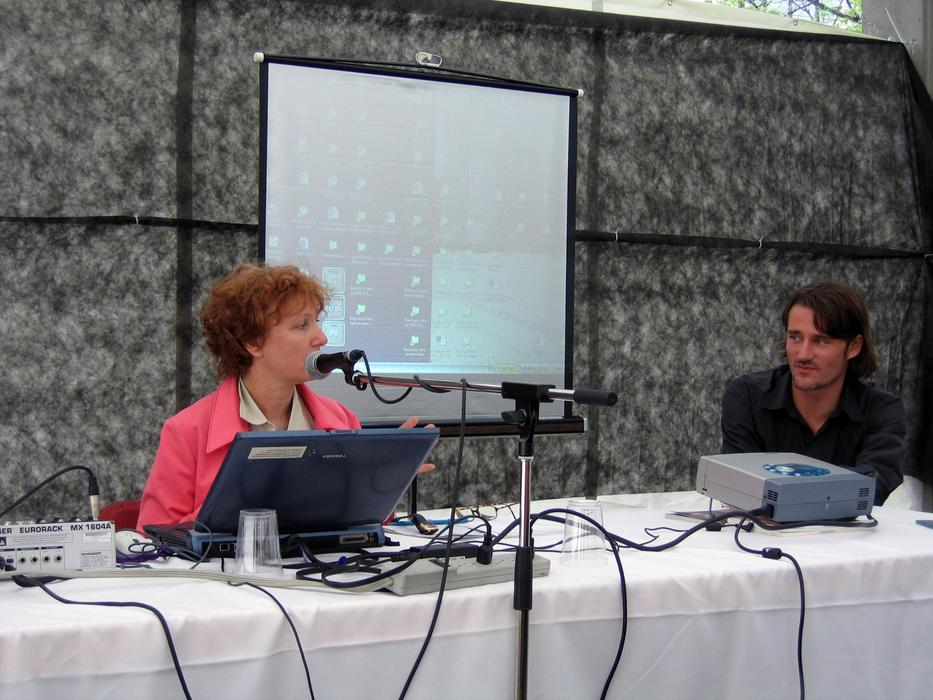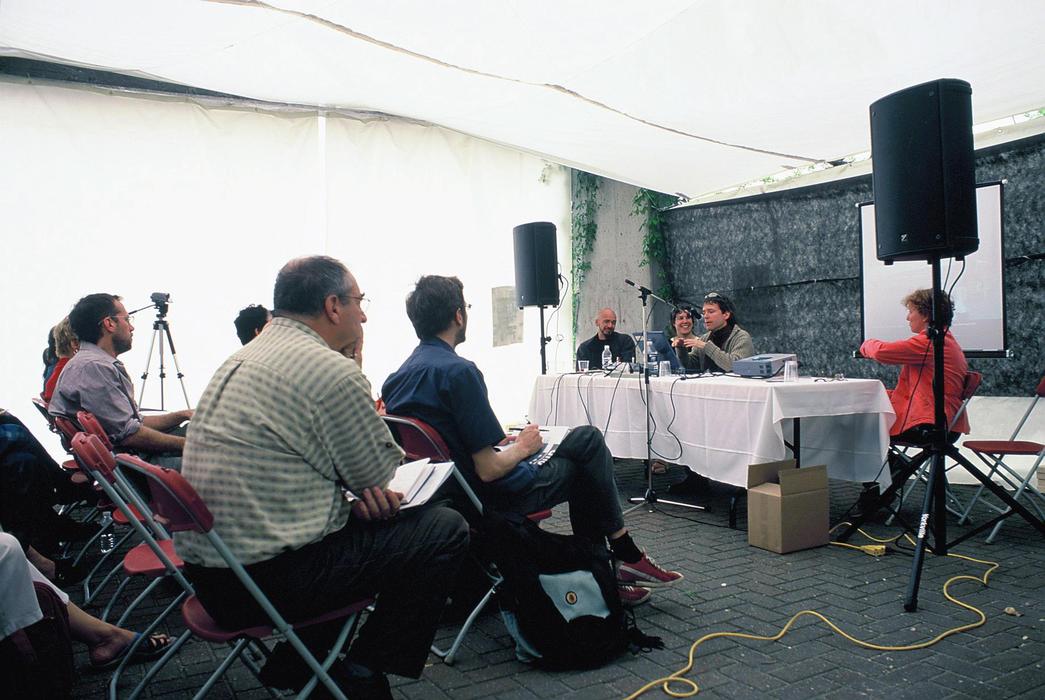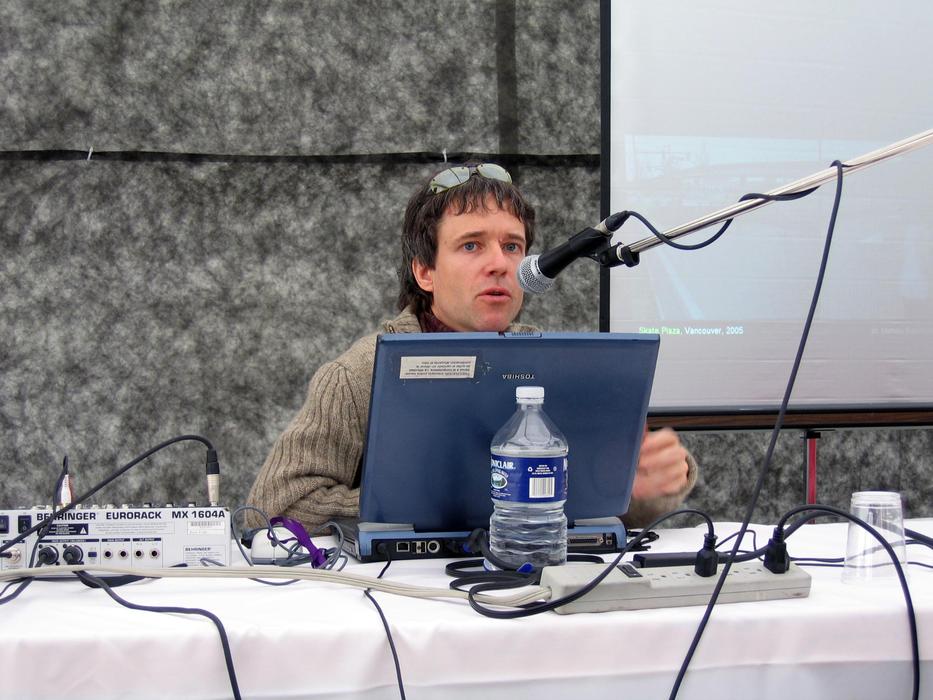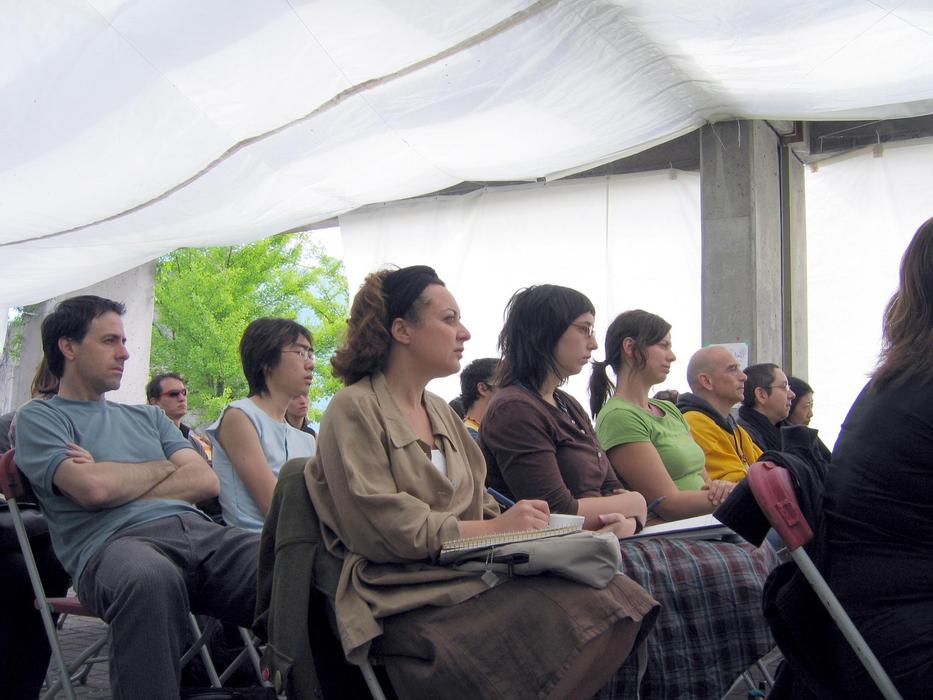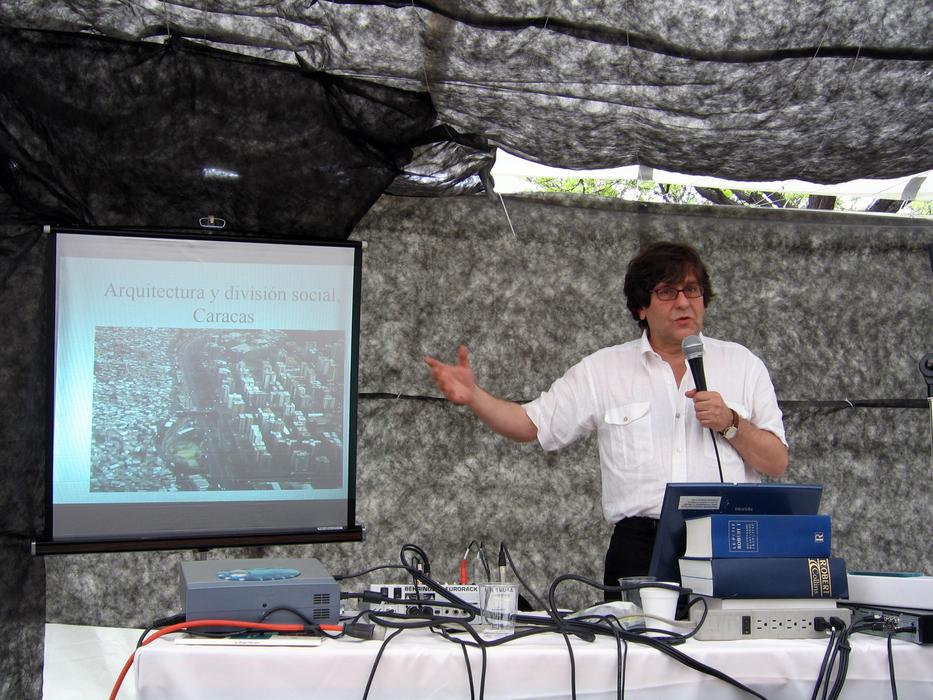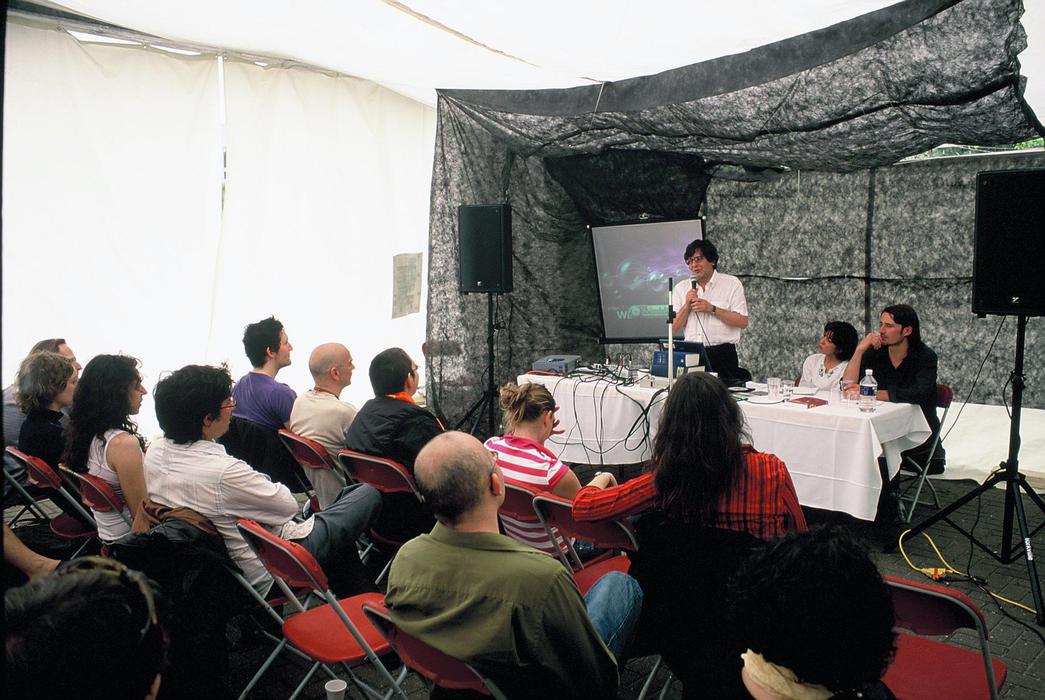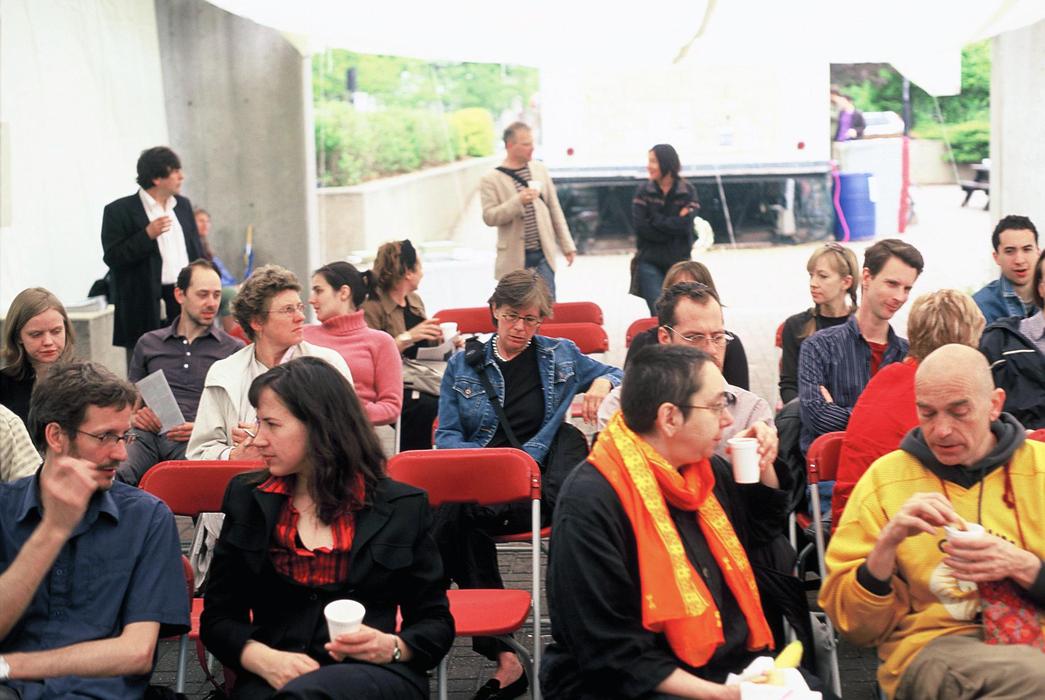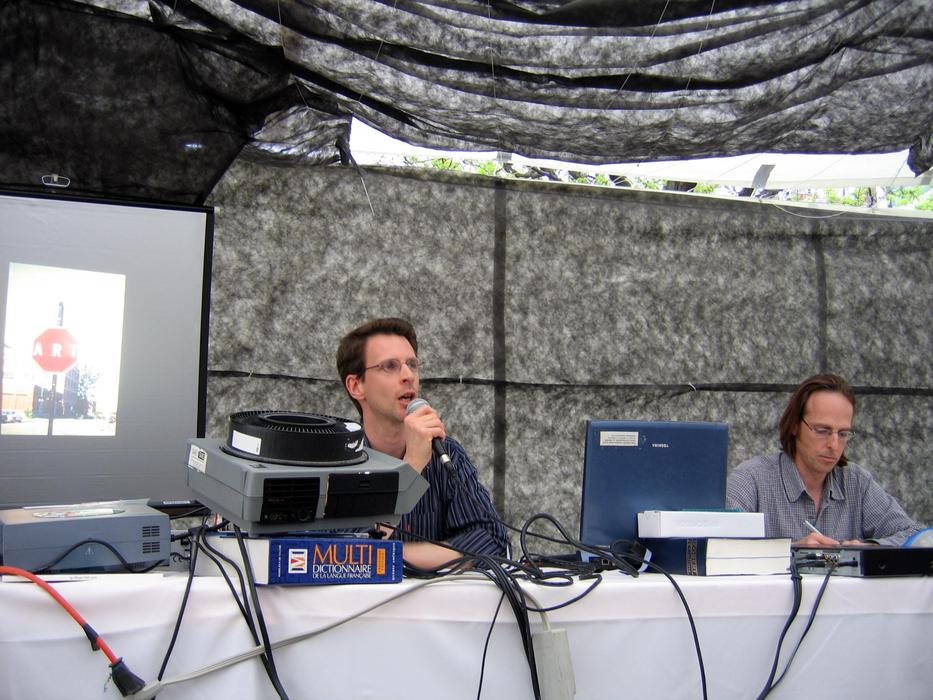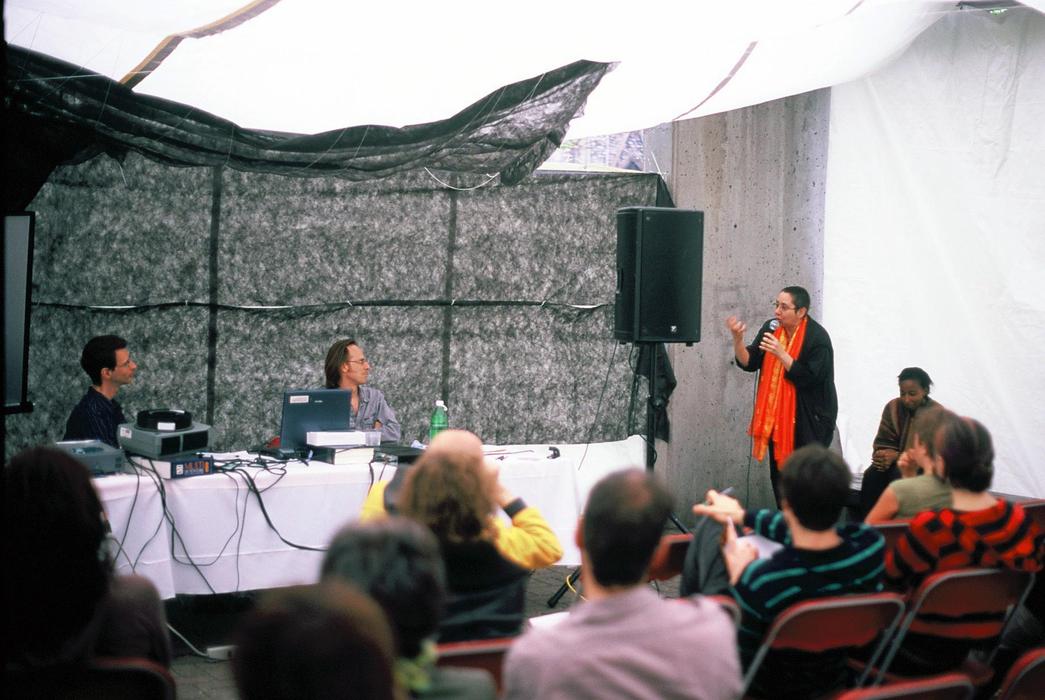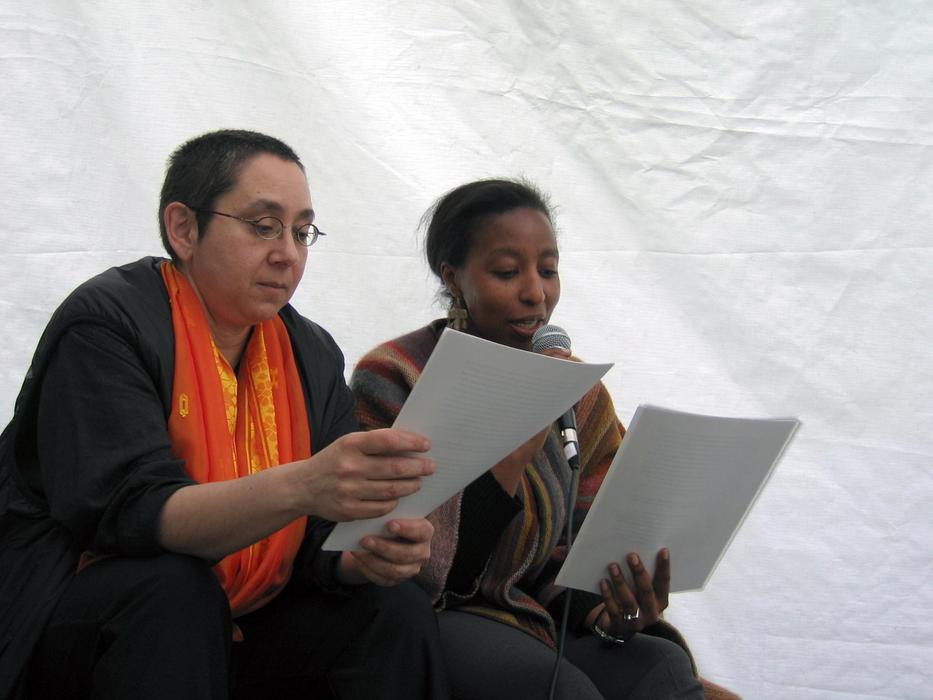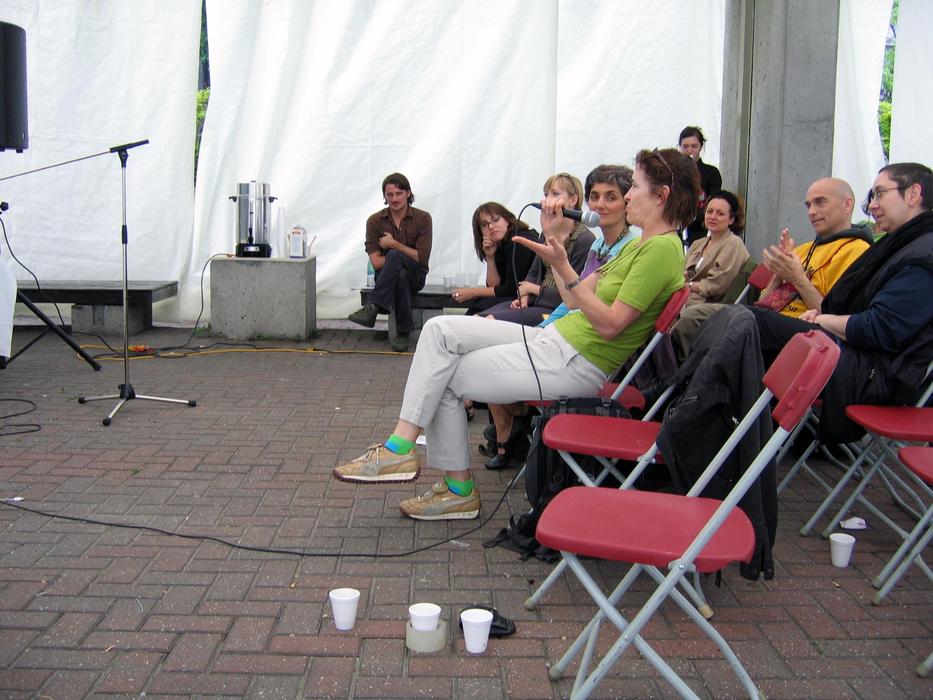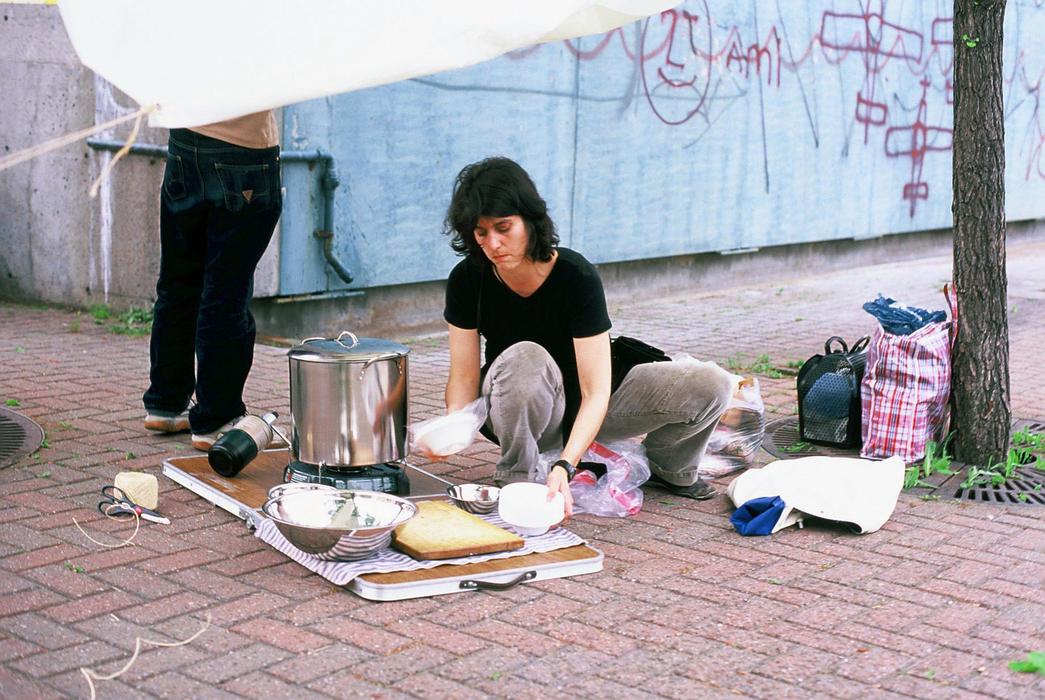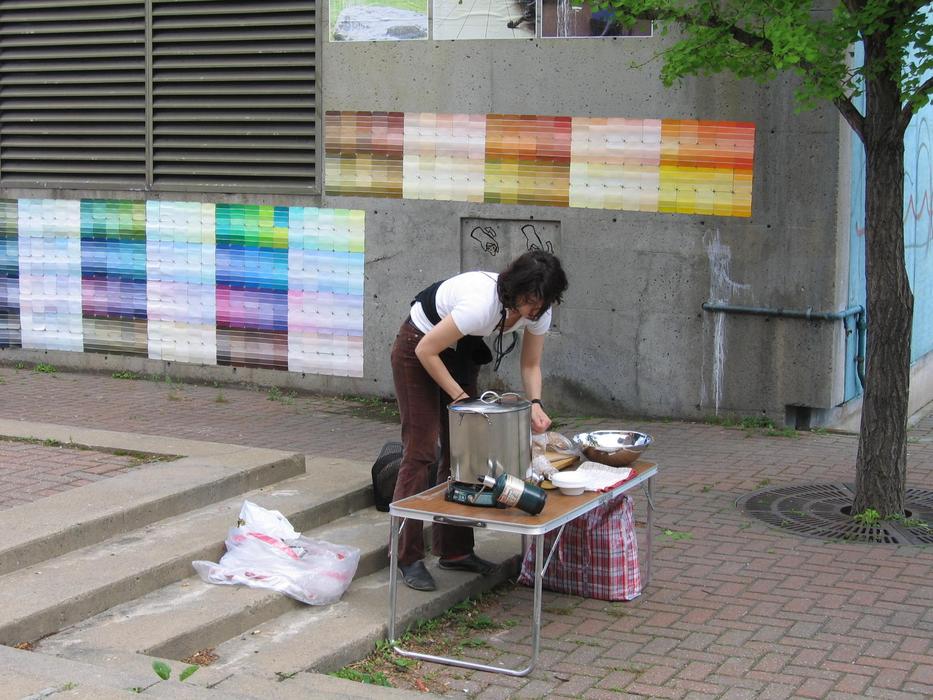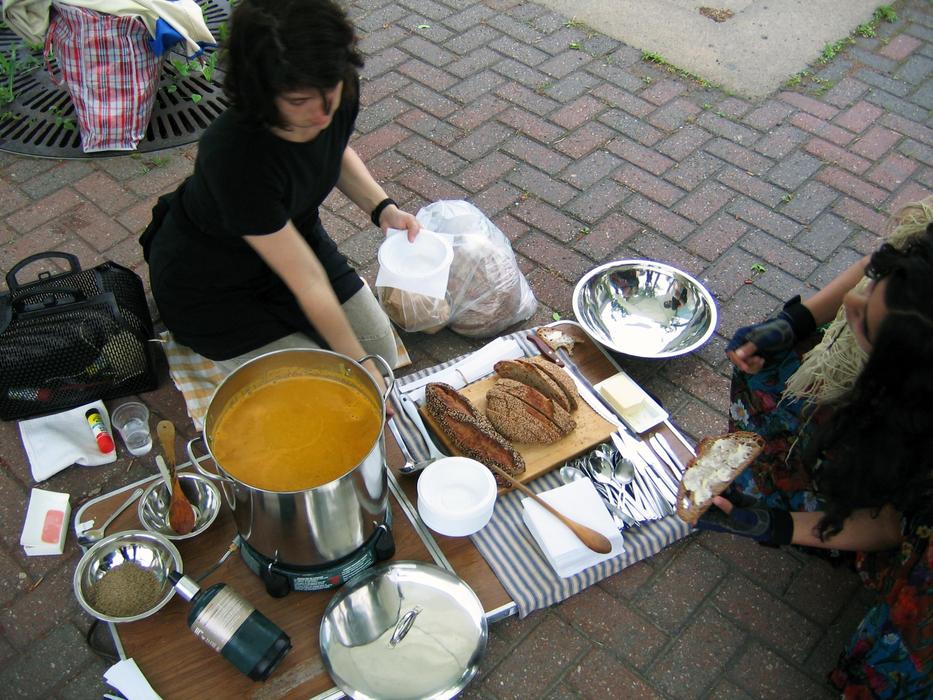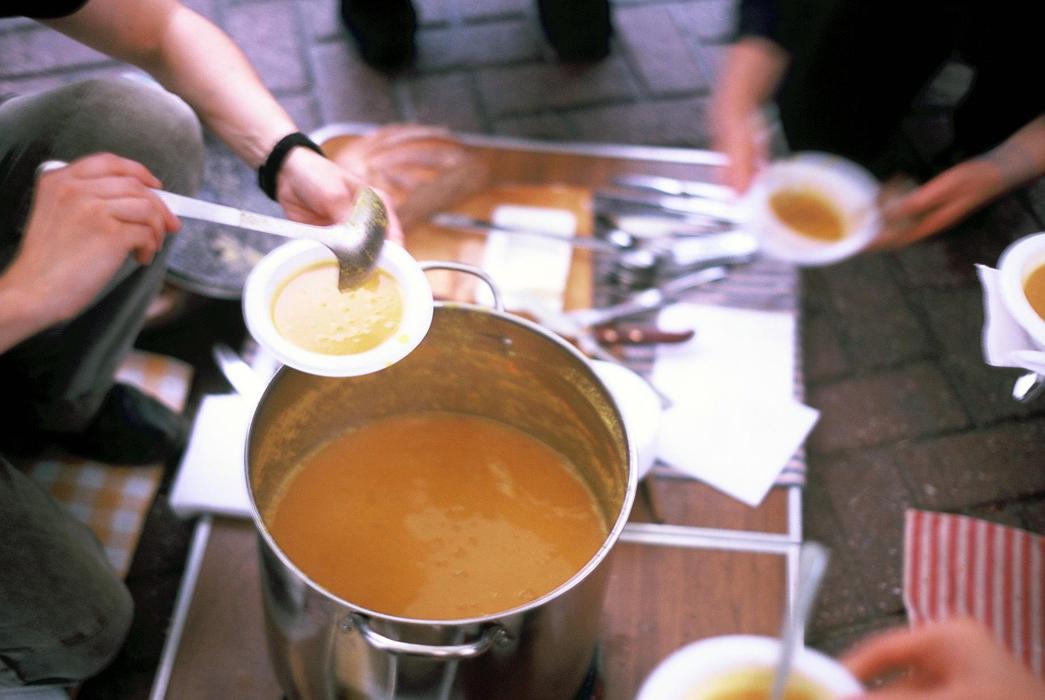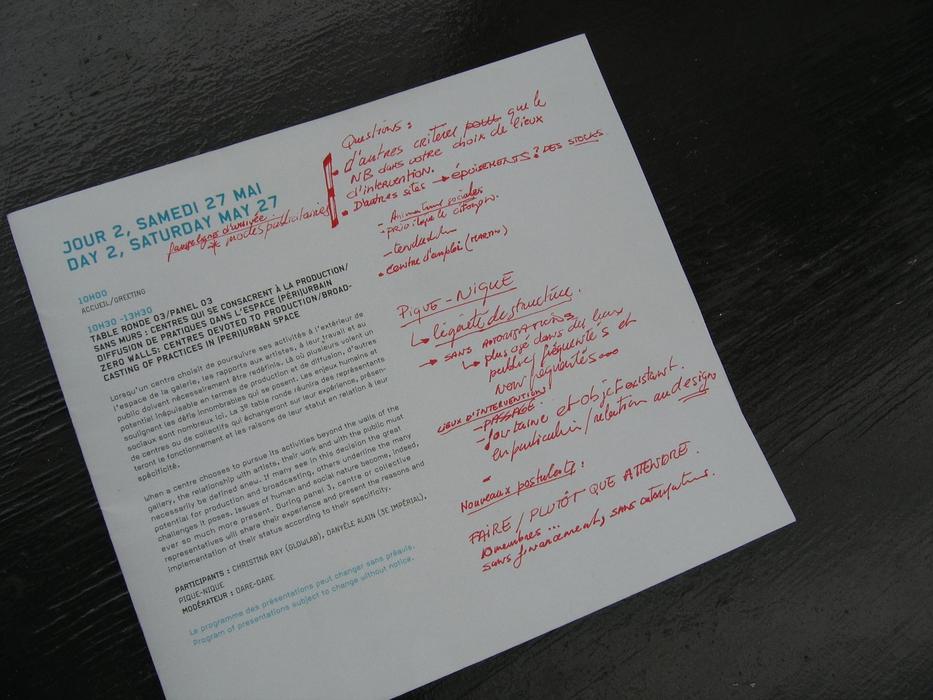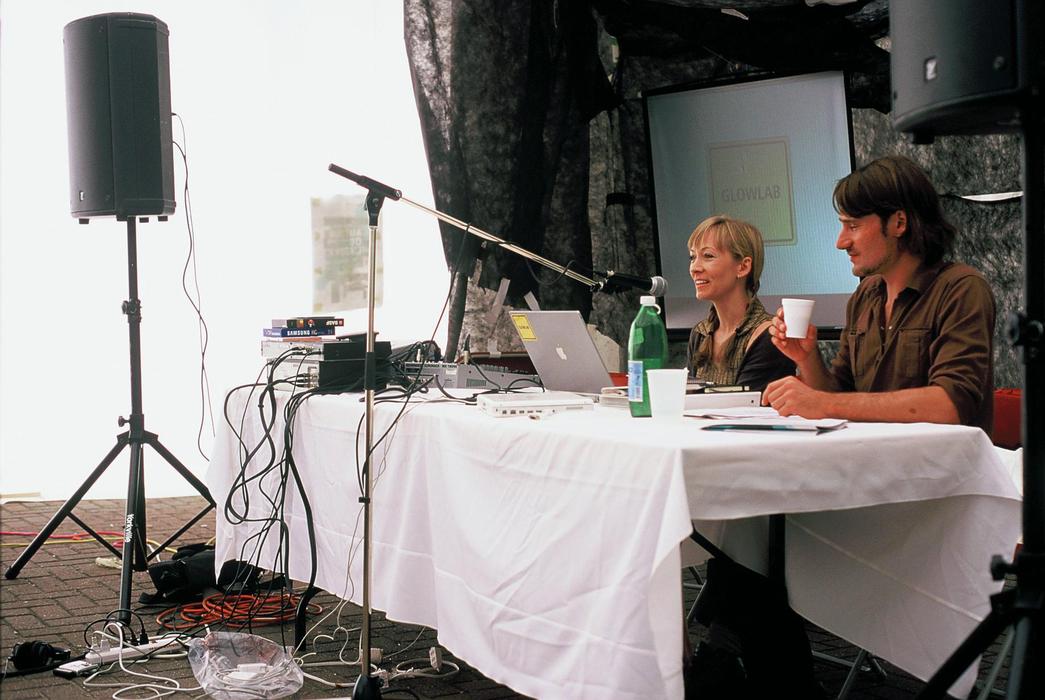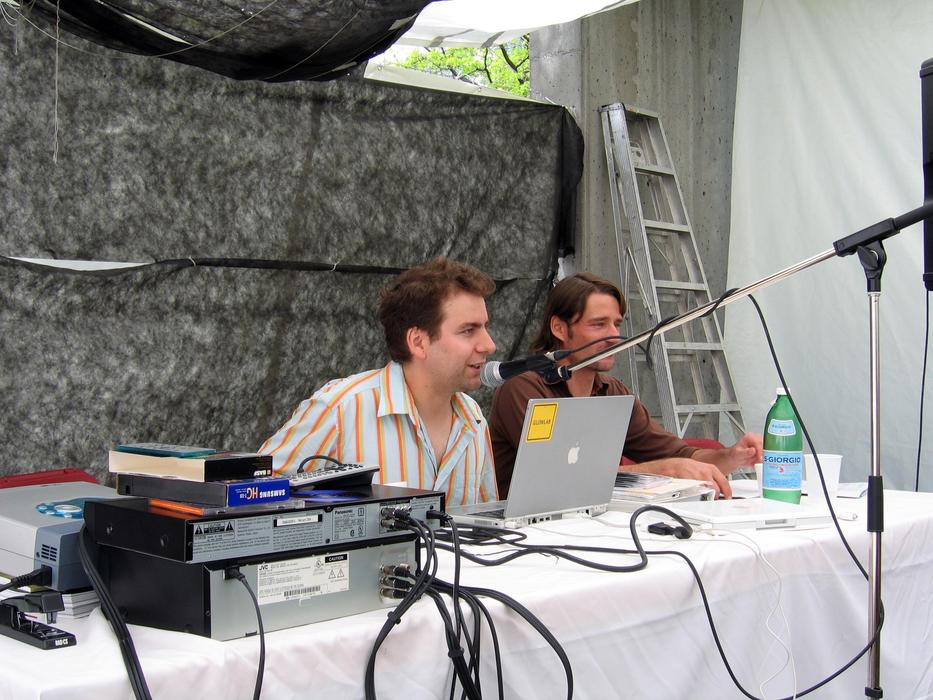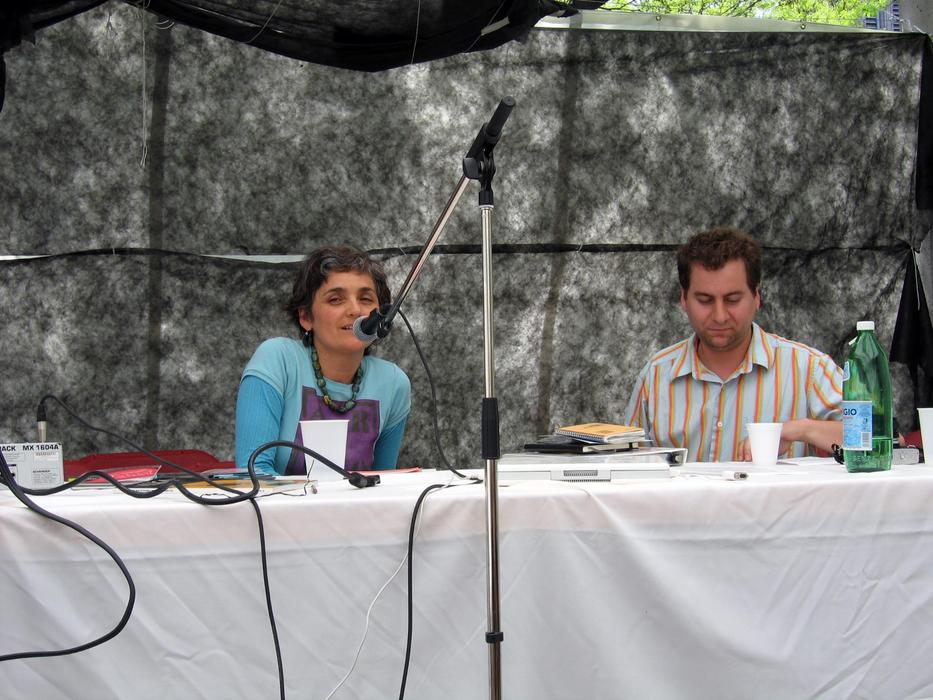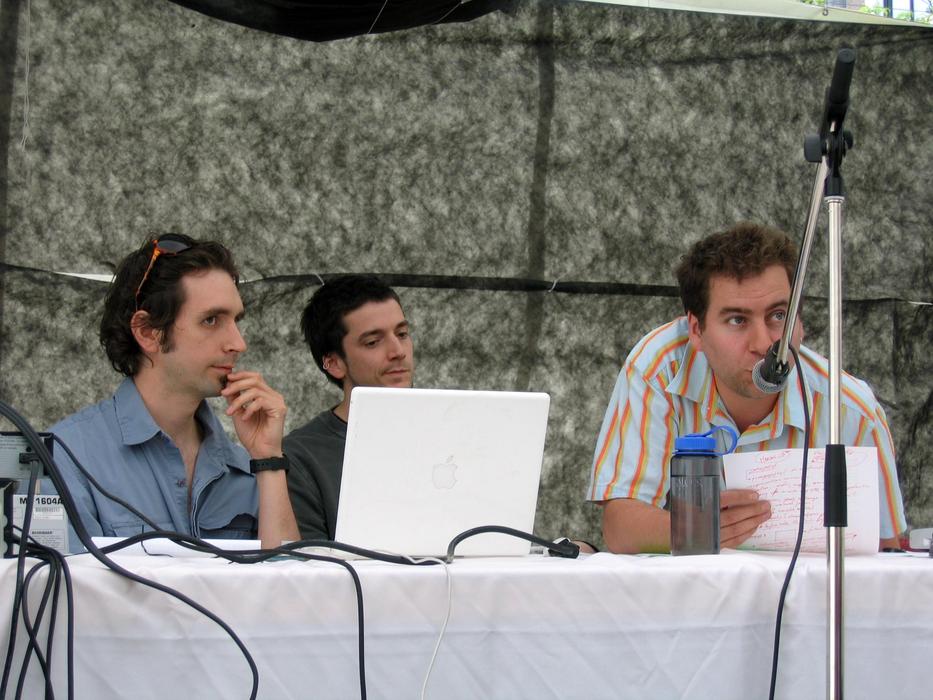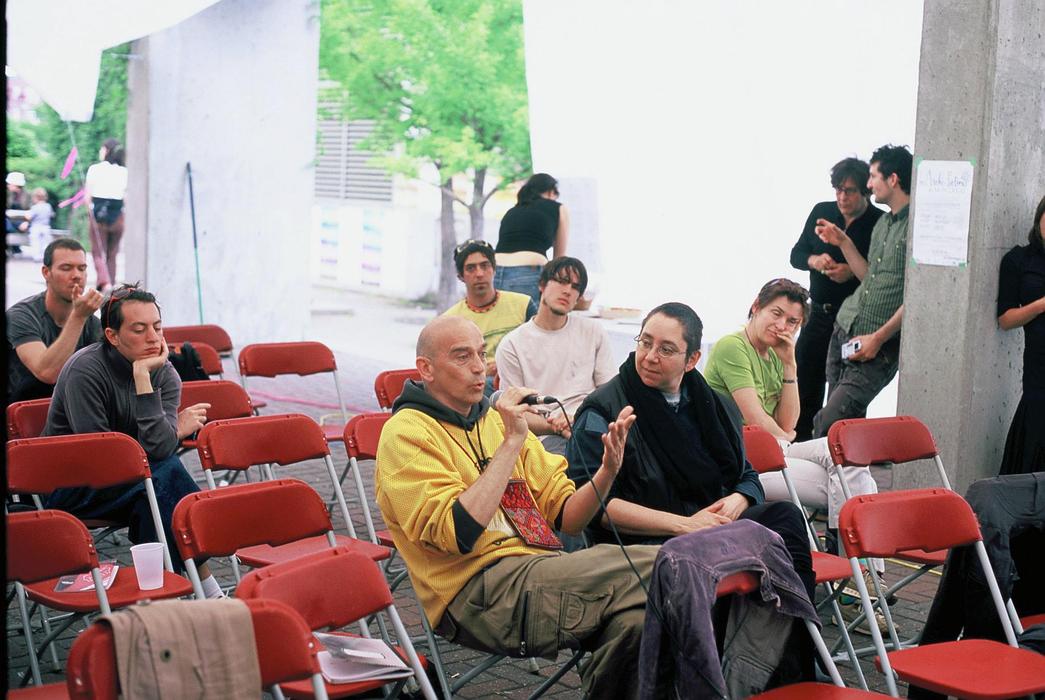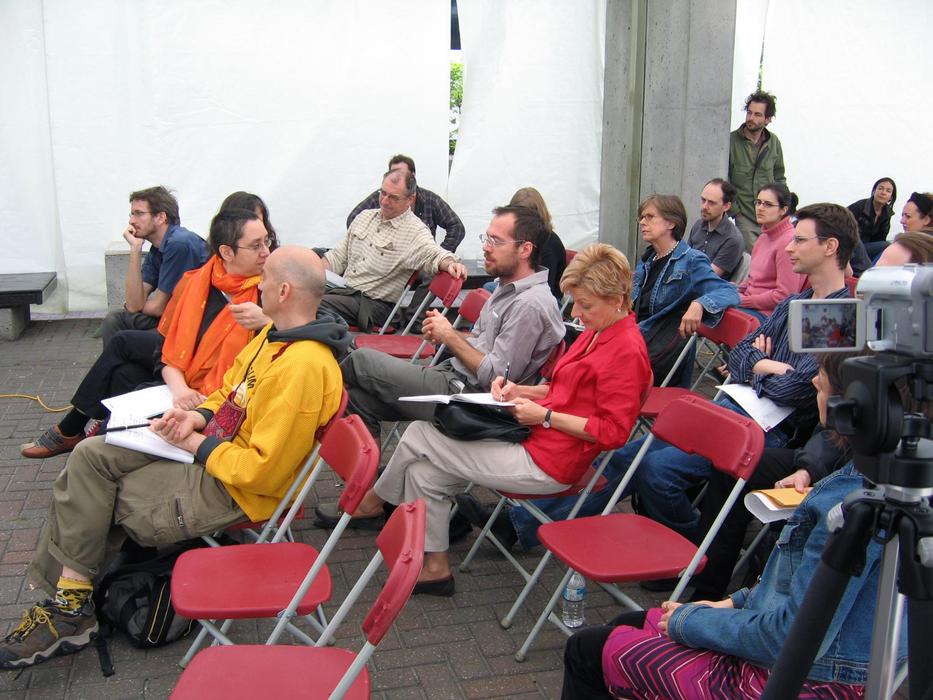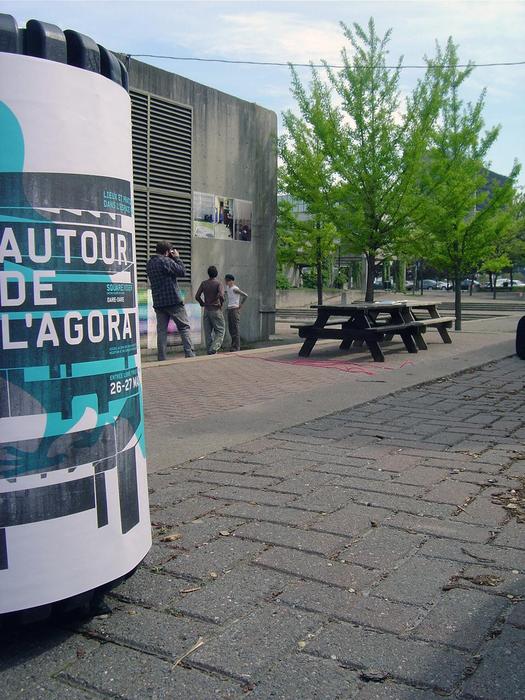Programming
Autour de l'Agora
Forum Event
DARE-DARE intends to continue its reflection and experience during the meetings Around the Agora, where artists, sociologists, architects and activists will present approaches, visions, modes of intervention aimed at rethinking the conceptualization, planning, development and organization of the urban landscape.
View more
In August 2004, DARE-DARE launched the Dis/location project and set up its trailer in Viger Square. In order to better reflect (on) the city, and to be physically and conceptually closer to the places of interest and practices of its members and those who participate in its programming, DARE-DARE chose to inscribe itself in the very fabric of the city, thus promoting artistic production and dissemination where exchange, encounter and experimentation prevail. New risks, exploration of new modalities and avenues of research, which may lead to a renewal and/or redefinition of the center's mandate and orientation.
The DARE-DARE program updates and reactivates a public space, certainly, giving it a specificity hitherto non-existent or undisclosed. But in an age of increased mobility, co-location, digital public spaces, privatization and urban sprawl, public places often remain underused or fall into disuse. Artistic intervention in the city influences the experience of a place, revitalizing it by encouraging short- or medium-term uses. To what extent does it influence the definition, location and design of public squares?
DARE-DARE intends to pursue its reflection and experience at the Autour de l'Agora meetings, where artists, sociologists, architects and activists will present approaches, visions and modes of intervention aimed at rethinking the conceptualization, planning and organization of the urban landscape. Speakers will be invited to discuss, among other things, new forms of public space based more on relational contribution and urban experience than on projected image. In this respect, the round table aims to explore and present other forms of intervention in the city, more ephemeral, contextual or minor, sometimes carried out at short notice, and will deal particularly with contextual practices, which consist in working with what already exists, at the frontier of art. It will also address the question of the relationship to place and the public, and the real impact of the presence of art in public space on the social and urban fabric.
Viger Square is the ideal site for this event. All things are ephemeral, and it will soon be razed to the ground. With Autour de l'Agora, DARE-DARE closes the first part of Dis/location: projet d'articulation urbaine.
Curator, Autour de l'Agora
_
Day 1, Friday May 26
Round Table 01
Designs for public space: reflections, processes and realizations
After the design of autonomous, self-sufficient megastructures, such as the such as the development of the Ville-Marie autoroute and Viger Square interest in micro-productions and flexible, permeable urban concepts and contextual urban concepts. More than the final design or visual appearance, individual initiatives to reconfigure open to strategic and collaborative conceptualization. collaborative conceptualization. This round table will examine the theoretical and practical foundations theoretical and practical underpinnings of these new approaches to public spaces.
Participants: Luc Lévesque, Stéphane Bertrand, Charlotte Gaudette (Mousse Architecture de Paysage)
Moderator: Sophie Gironnay
Presentation
Armando Silva (Bogotá)
Translator: Helena Martin Franco
Moderator: Jean-François Prost
Round Table 02
In the public space: artistic and urban practices in relation to planning
Today, artists are increasingly working and exhibiting outside the context the context traditionally assigned to them: the gallery. The are many and legitimate, but their repercussions, whether direct or indirect their repercussions, whether direct or indirect, are more often questioned than observed. questioned rather than observed. Because the long-term impact on urban experience is often dissociated from these practices because of their their ephemeral and temporary nature. They do, however, suggest a a new, critical look at how the city is organized and experienced. and how we live in the city. The 2nd round table will address the impact of these urban practices on the design and layout of cities and social life.
Participants : Patrice Loubier, Devora Neumark
Moderator: Louis Jacob
Cocktail
Screenings Dialécticas Urbanas, Alegorías sobre Caracas by John Frankfurt, Alfredo Brillembourg & Hubert Klumpner (Urban Think Tank Films) and Viger (the movie) + Reality Show by Video Paradiso, gourmet performance by Marie-Andrée Rho
Day 2, Saturday May 27th
Round Table 03
Without walls: centers dedicated to the production/diffusion of practices in (peri-)urban space
When an artist-run center chooses to pursue its activities outside the gallery space gallery space, relationships with artists, their work and the public must necessarily be redefined. Where many see inexhaustible potential in terms of production and dissemination, others others point to the countless challenges that lie ahead. The human and social and social issues. The 3rd round table will bring together representatives centers and collectives to share their experiences, the way they operate and the reasons for their status in relation to their specificity.
Participants: Christina Ray (Glowlab), Danyèle Alain (3e Impérial), Jason Arsenault et Mathieu Valade (Collectif Pique-Nique)
Moderator: Jean-Pierre Caissie and Jean-François Prost
Participants
Danyèle Alain pursues a multidisciplinary approach based on the notions of transformation and exchange and on the contextual relation to the place. Her work has been presented in Quebec, Canada, France, Mexico. She lives in Roxton Pond in Montérégie. She has been actively involved in the arts and culture scene for many years and works at the General and Artistic Direction of the 3e Impérial in Granby, where she has contributed over the past 12 years to develop a residency and public art formula that explores the sensitive and sometimes eccentric areas of social and geographical territory.
Armando Silva is professor of aesthetics and visual thinking at the Universidad Nacional de Colombia, and director of the Urban Cultures in Latin America from the social imaginary project. He lives and works in Bogotá. His latest book, Urban Imaginaries from Latin America, was published by Documenta XI. He teaches in several universities in Latin America, Europe and the United States and collaborates in numerous journals and periodicals. He is invited to the 2006 Venice Biennale and, in 2007, the Tapies Foundation of Barcelona will present a retrospective of all his work.
Louis Jacob is a professor in the Department of Sociology at Université du Québec à Montréal. In recent years, and particularly with his activities at the Artexte Information Center, he is interested in contemporary artistic practices and their insertion in the public space. One will have a glimpse of his research on art and urban space in his article "Specific Spectacles: Criticism, Assumption and Regression of the Spectacular in the System of Contemporary Art", Sociology and Society, No. 1, 2005.
Devora Neumark is an artist, teacher and activist. Exchange and voluntary vulnerability as a force are inherent in her interdisciplinary practice. Her work explores the relationship between art, conflict and healing. Sometimes taking the form of contextual projects and live relational performances, her research includes disciplines that are often isolated from each other: theories of trauma, sciences of consciousness, physics, ethics, phenomenology and creativity. Co-director of the LEVIER d'Engrenage Noir project, Neumark encourages collaboration between artists and community groups. She is a faculty member of the Interdisciplinary Art program at the Master of Fine Arts at Goddard College. Neumark has been a volunteer and vice-president of Shalom Inn for Women Victims of Domestic Violence, supports Palestinian self-reliance and has completed volunteer training at the Centre du bien-être et pour le service des soins palliatifs de l'Hôpital général juif de Montréal.
Luc Lévesque is an architect, artist and lecturer at the Faculty of Planning at Université de Montréal where he is pursuing a PhD on the notion of interstitial landscape. In 2000, he co-founded the urban exploration workshop Syn- in which he realized several urban maneuvers. Between 1993 and 2000, with the multidisciplinary collective Arqhé, he designed the series of on-site multimedia interventions Line of site (I to V). As a member of the editorial board of the current Inter Art magazine, he has directed several papers on architecture, landscape and urban practices; he also writes in different publications. In architecture, he collaborated on the Zoom workshop and worked in the offices of Peter Eisenman (New York) and Rem Koolhaas / OMA (Rotterdam).
Christina Ray, artist and curator, lives and works in Brooklyn. Her projects examine the interrelationships between place and experience. She is the founder of Glowlab, a production and publication laboratory run by artists, which makes the urban public space the vehicle for contemporary and technological art projects. Director of Glowlab, Ray has accumulated accomplishments: curator of events and exhibitions, publisher of Glowlab's Internet magazine, producer of Conflux, an annual psychogeography festival in New York. For her projects, Ray uses a range of media: street scene photography and documentary projects, interactive web projects, walks and participatory games, drawing and installation. She has exhibited in numerous galleries in the United States and abroad and is represented by DCKT Contemporary (New York).
Mousse architecture was founded by Emmanuelle Tittley and Charlotte Gaudette. Both of them are committed to socially committed projects that respect the environment. They have been active for several years in the creation of outdoor spaces for day care and schools in the Montreal area and in Quebec's Far North. The two designers regularly reserve part of their practice to explore new vocabularies through temporary garden projects and facilities. This earned them an award from the Montreal Institute of Design for the Catimini garden presented in 2002 at the International Festival of Jardins de Métis.
Patrice Loubier is an independent art critic. Interested in contemporary forms of creation, he has written on installation, performance, in situ and interdisciplinarity projets, and on the art of intervention and stealthy practices. With Anne-Marie Ninacs, he is behind Commensaux, a special program for Skol Center for Contemporary Arts in Montreal, in 2000-2001. In the spring of 2005, he co-signed the Manif d'Art 3 of Quebec with André-Louis Paré. He is a lecturer at the Université du Québec à Montréal.
Pique-nique, founded in 2001, is a collective of artists whose mandate is to produce and encourage the spontaneous intrusion of works or artistic actions into the public space. Pique-nique annually invests a public place for a day and transforms it into a space for creation, dissemination and discussion. The collective organizes and participates in various events through which members offer different proposals that take a skeptical and amused look at the place to invest. These events include: Pique-nique avec Pique-Nique!, Maison de la culture Côtes-des-Neiges, and at Manèges urbains, Caravansérail, Rimouski. Pique-Nique favors no form of expression or speech except perhaps that of the incongruous, the challenging and the surprising.
Stéphane Bertrand is a landscape architect and urban planner. His intervention expertise on urban wastelands leads him to reflect on the fundamental nature of the landscape as a cultural and social construction, whose transformations are significant beliefs and values of a community. Curator of visual arts, he organizes several events in collaboration with AXENÉO7. He also sits on the board of Champ libre. Corbeil & Bertrand Landscape Architects, of which he is a partner, realizes many landscaping and garden installations in Canada and abroad, including DÉS / ORDONNANCE, which won an award of excellence from the Association des architectes landscape designers. Stéphane is organizing an event planned for 2008-2010 that will take place on vacant lots in Montreal and then Berlin.
Sophie Gironnay is the General and Artistic Director of MONOPOLI, Architecture Gallery, a non-profit organization whose mission is to stimulate and disseminate the creation and reflection of the disciplines of architecture, landscape architecture and architecture. urbanism. She has a dual background in literature and art history. Cultural journalist, creator of the weekly columns Formes (Le Devoir) and Figures (La Presse) on architecture from 1994 to 2003, S. Gironnay also held a column on Anglo-Canadian literature for four years, at Le Devoir and news. Guest curator at the Musée du Québec and the Biennale de Montréal, she co-founded MONOPOLI in 2001.
Jean-François Prost is an artist with a degree in environmental design (UQAM) and architecture (Carleton University). Focusing on the new urban research territories located on the margins of the areas usually occupied by artistic intervention and development, he rethinks and questions the city in a non-disciplinary way, combining urban interventions, installations and maneuvers. His individual work, in duo or in collaboration with the Syn- workshop, has been presented in several centers in Canada and at international events. His current research will be the subject of a series of urban interventions / exhibitions in 2006 in the cities of Ottawa-Gatineau and Liverpool. He has been a member of the board of DARE-DARE for several years.
Special thanks:
The team:
Jean-François Prost: coordinator, Around the Agora
Jean-Pierre Caissie: artistic coordinator
Marianne Thibeault: Administrative Coordinator
Émilie Terrasse: trainee + video documentation
Frank Nobert: translation + revision
Jean-Maxime Dufresne: sound documentation + technical assistance
This project was made possible thanks to the financial support of the Conseil des arts et des lettres du Québec.
